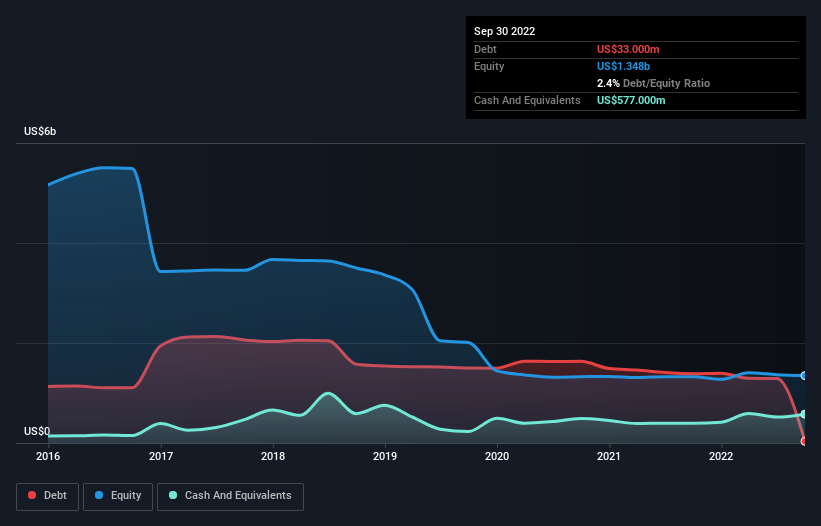- United States
- /
- Professional Services
- /
- NasdaqGS:CNDT
We Think Conduent (NASDAQ:CNDT) Can Stay On Top Of Its Debt
David Iben put it well when he said, 'Volatility is not a risk we care about. What we care about is avoiding the permanent loss of capital.' So it might be obvious that you need to consider debt, when you think about how risky any given stock is, because too much debt can sink a company. We note that Conduent Incorporated (NASDAQ:CNDT) does have debt on its balance sheet. But is this debt a concern to shareholders?
Why Does Debt Bring Risk?
Debt assists a business until the business has trouble paying it off, either with new capital or with free cash flow. In the worst case scenario, a company can go bankrupt if it cannot pay its creditors. However, a more frequent (but still costly) occurrence is where a company must issue shares at bargain-basement prices, permanently diluting shareholders, just to shore up its balance sheet. By replacing dilution, though, debt can be an extremely good tool for businesses that need capital to invest in growth at high rates of return. When we examine debt levels, we first consider both cash and debt levels, together.
Check out the opportunities and risks within the US IT industry.
What Is Conduent's Debt?
You can click the graphic below for the historical numbers, but it shows that Conduent had US$33.0m of debt in September 2022, down from US$1.39b, one year before. But on the other hand it also has US$577.0m in cash, leading to a US$544.0m net cash position.

How Healthy Is Conduent's Balance Sheet?
We can see from the most recent balance sheet that Conduent had liabilities of US$933.0m falling due within a year, and liabilities of US$1.64b due beyond that. Offsetting these obligations, it had cash of US$577.0m as well as receivables valued at US$867.0m due within 12 months. So its liabilities total US$1.13b more than the combination of its cash and short-term receivables.
Given this deficit is actually higher than the company's market capitalization of US$824.8m, we think shareholders really should watch Conduent's debt levels, like a parent watching their child ride a bike for the first time. In the scenario where the company had to clean up its balance sheet quickly, it seems likely shareholders would suffer extensive dilution. Conduent boasts net cash, so it's fair to say it does not have a heavy debt load, even if it does have very significant liabilities, in total.
Also relevant is that Conduent has grown its EBIT by a very respectable 28% in the last year, thus enhancing its ability to pay down debt. When analysing debt levels, the balance sheet is the obvious place to start. But ultimately the future profitability of the business will decide if Conduent can strengthen its balance sheet over time. So if you want to see what the professionals think, you might find this free report on analyst profit forecasts to be interesting.
Finally, a company can only pay off debt with cold hard cash, not accounting profits. Conduent may have net cash on the balance sheet, but it is still interesting to look at how well the business converts its earnings before interest and tax (EBIT) to free cash flow, because that will influence both its need for, and its capacity to manage debt. Happily for any shareholders, Conduent actually produced more free cash flow than EBIT over the last three years. There's nothing better than incoming cash when it comes to staying in your lenders' good graces.
Summing Up
While Conduent does have more liabilities than liquid assets, it also has net cash of US$544.0m. The cherry on top was that in converted 138% of that EBIT to free cash flow, bringing in US$22m. So we don't have any problem with Conduent's use of debt. When analysing debt levels, the balance sheet is the obvious place to start. However, not all investment risk resides within the balance sheet - far from it. To that end, you should learn about the 2 warning signs we've spotted with Conduent (including 1 which is potentially serious) .
At the end of the day, it's often better to focus on companies that are free from net debt. You can access our special list of such companies (all with a track record of profit growth). It's free.
New: AI Stock Screener & Alerts
Our new AI Stock Screener scans the market every day to uncover opportunities.
• Dividend Powerhouses (3%+ Yield)
• Undervalued Small Caps with Insider Buying
• High growth Tech and AI Companies
Or build your own from over 50 metrics.
Have feedback on this article? Concerned about the content? Get in touch with us directly. Alternatively, email editorial-team (at) simplywallst.com.
This article by Simply Wall St is general in nature. We provide commentary based on historical data and analyst forecasts only using an unbiased methodology and our articles are not intended to be financial advice. It does not constitute a recommendation to buy or sell any stock, and does not take account of your objectives, or your financial situation. We aim to bring you long-term focused analysis driven by fundamental data. Note that our analysis may not factor in the latest price-sensitive company announcements or qualitative material. Simply Wall St has no position in any stocks mentioned.
About NasdaqGS:CNDT
Conduent
Provides digital business solutions and services for the commercial, government, and transportation spectrum in the United States, Europe, and internationally.
Adequate balance sheet and slightly overvalued.
Similar Companies
Market Insights
Community Narratives




